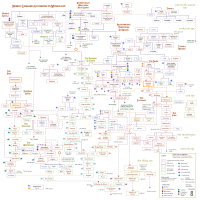 |
 |
 |
 |
 |
 |
 |
||||
|
Nordic Lineages According to Sagas This is a somewhat different attempt to explain Nordic mythology. More or less legendary and pseudo-historic lineage scraps from several tens of sources have been merged together into a family tree. A lot of this is mere speculation, and may contain quite a few erroneous conclusions. Mythology, as such, is a difficult subject to unify in any case, due to fragmentation, truncation of timelines, and so on. Besides, all material here can be subject to revision at any time, if the need for corrections or changes arises. This project is not 100% serious, even if I generally think many folk stories might have at least some sort of basis in real events. To summarize, such pseudo-mythological genealogy lists and sagas as How Norway was Discovered combined together with for instance the Orkneyinga Saga, Scondia Illustrata, Gesta Danorum, the Origins and Deeds of the Goths, and the Anglo-Saxon Chronicle, to name a few, suggest that mythology-wise, the royal lineages of Norway, Denmark, Normandy, the Great Britain, and Geatish terrains might have descended from a line of Finnic kings that governed Finland, Kvenland, and Gotland from the late bronze age to the late Pre-Roman era (the latter assumption has been derived from Messenius' writings). This primal ancestral line, which likely originated from Kvenland (Kalanti-Kainuunmaa of Finland) belonged to the Jotuns (Norse), better known in the Finnic Kalevalaic poetry as the the Kalevanpojat. My method of tracking Finnic counterparts or names for the giants listed in Norse sources is based either on direct translation, finding similarities in Norse and Finnic accounts, using fragments of existing theories and plain guesswork, or trying to see whether a certain name might be a phonetic twist that has happened when the name has been carried through several dialects of different languages over the centuries. This is a very common phenomenon, and sometimes the original meaning of the name becomes partly or entirely mangled. One example from the present-day Finland would be a city called Uusikaarlepyy whose initial name in Swedish is Nykarleby. Let us chop the name in parts. Ny, 'new', has been translated to Finnish, which is 'uusi', 'new'. 'Karl' is a male name, which has been twisted to Kaarle in Finnish. The Swedish 'by' means 'town, village', but this has become mangled in the Finnish form. 'Pyy' is means 'hazel grouse'. 'The new town of Karl' has thuswise been messed up into 'new Kaarle hazel grouse'. Anyhow, it would seem that it was a common conduct for the minstrels and composers of sagas to translate 'foreign' names into Old Norse, if they had the chance (compare the Kvenlandish king Kaukamoinen, 'far-reaching one', to Faravid, approximately 'far-wide, far-reaching'). Hence, mangling would have been very frequent, if the exact meaning of the name was unknown or untranslatable. Saxo Grammaticus is somewhat infamous for his similar-type Latinizing of Old Norse names. For instance, Útgarða-Loki was warped into Utgarthilocus, which has no meaning at all. Presently the tree is in an incomplete state, and will be worked with over time. I have inserted some approximate time scales to add a bit of coherency. It isn't very 'artistic', since a certain degree of readability has to be retained. Even as such, it's quite a jumble inside a tangle. The project is available in two versions, a gif image and a pdf file. Click the thumbnail or text for the appropriate file. Version 1.0 in gif format, c. 300kb 
Version 1.0 in pdf format, c. 200kb ¤¤¤ Incomplete list of references |
||||||||||
Best viewed with: Firefox ++ c. 1280x1024 ++ a sense of humor. Disclaimer: |